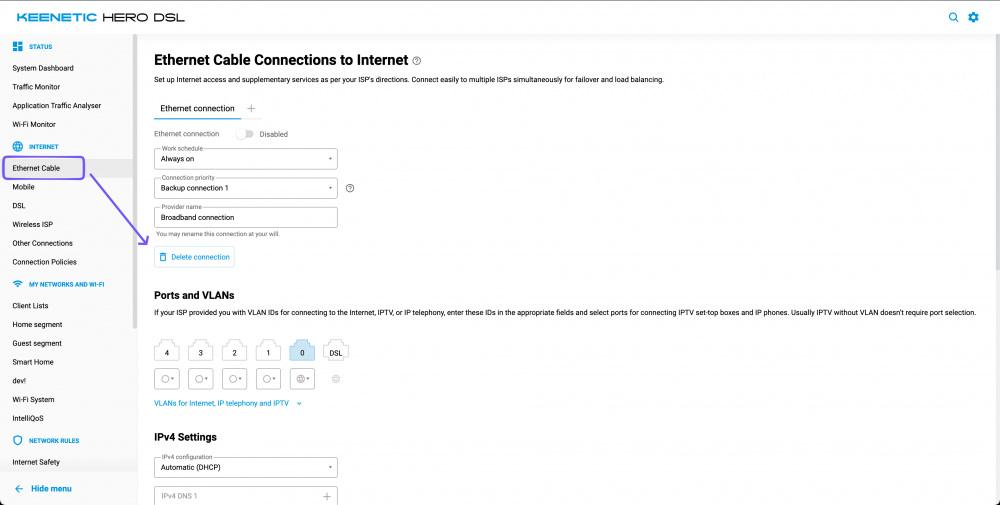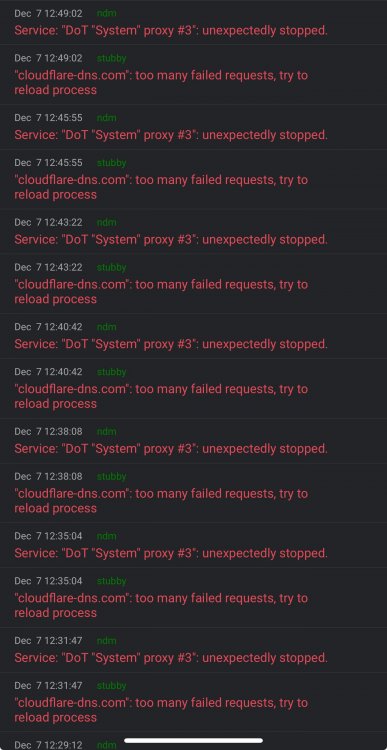All Activity
- Today
-
SnogmoxNep joined the community
-
cirf joined the community
-
Добрый день! Добавьте функцию перезагрузки роутера по питанию если не проходит проверка интернет-соединения. Настройка pingcheck не работает, как понял она работает только с USB, а при подключении к модему-роутера ничего не происходит. Иногда пропадает интернет и встроенный в роутер модем (kn-2910) перестает работать. Помогает только перезагрузка роутера.
-
kabakevichnv joined the community
-
FrankLog joined the community
-
Antonzed joined the community
- Yesterday
-
wildcatzita started following Rebooting Sprinter (KN-3711) UA
-
Router using 5GHz and 2.4Ghz with 802.1ax. After connecting 11-inch iPad Pro 2018 and Philips TV via 5Ghz router starts reboting. Even If one device on 2.4 Ghz and another on 5Ghz it doesn't help. Only If I disable 802.1 ax router start working. Is there any solution how to have 802.1ax and old device can work properly?
-
wildcatzita joined the community
-
{PROBLEM} DNS DOT proglem with 5.0.2
bora ozver replied to bora ozver's question in Dev channel issues & test reports
Yok hala sorun devam ediyor cf saglam - Last week
-

{PROBLEM} DNS DOT proglem with 5.0.2
Ahmed Ensar replied to bora ozver's question in Dev channel issues & test reports
cf arada patlıyordu orayami denk getirdin, sorun hala devam ediyormu yani. -
Hi, i found a problem on my "Client list" section. I have 2 Titan units, one router and another mesh access point. A lot of my devices who are connected to the access point show 2500 Mbits/s instead of Speed and security protocol as show on this pic. Is this a bug? Thanks
-
Hi, i use QoS bandwith settings for dealing with bufferbloat. i have slow internet connection (12/3 mbit) and i wouldnt prefer to lose whole 1Mbit/s speeds to deal with bufferbloat. i dont know if there is a technical requirements for defining speed limit for megabits, if not, defining kilobit speeds will help people with slow speeds. i have Hopper DSL (KN-3610), with stable 4.3.6.3 firmware, it only shows megabit/second
-
{PROBLEM} DNS DOT proglem with 5.0.2
bora ozver posted a question in Dev channel issues & test reports
Hello, since I upgraded to version 5.0.2, I am receiving an error message in DOT DNS, which I have never received before. Please inform me. - Earlier
-
Release 5.0.2: Core: fixed access to sensitive data for users with "readonly" privileges [NDM-4169] DNS: fixed "stubby: Could not parse config file" error when using DoT (reported by @snark) [NDM-4125] DNS: fixed system crash in "DNS FQDN event sink" threads [NDM-4162] IPv6: fixed parsing "ipv6 static" commands with comments (reported by @avn) [NDM-4098] MWS: fixed Extender connection through WAN (blue) port (reported by @Zoomer88) [SYS-1483] Tools: added "source-address" parameter for "tools iperf3" [NDM-4176] Web: added eSIM configuration page [NWI-4526] Web: fixed "components list: execute denied" error for users with "manager" privileges (reported by @dimon27254) [NWI-4532] Web: fixed "Enable SNTP service" checkbox (reported by @qmxocynjca) [NWI-4561] Web: fixed a warning about missing password when navigating from RMM [NDM-4170] Web: removed text reduction for fail-safe pop-up (reported by @dimon27254) [NWI-4554] Web: updated the Transition Log display on mobile screens (reported by @dimon27254) [NWI-4549] Wi-Fi: fixed ACL filtering for Wi-Fi 7 clients with MLO enabled [SYS-1507] Wi-Fi: fixed compatibility with iPhone 17 when Wi-Fi 7 MLO and Fast Transition are enabled [SYS-1497] Wi-Fi: fixed MWS zoning for Wi-Fi 7 clients with MLO enabled [SYS-1505]
-
When using the «Folder permissions control» component together with «SFTP Server» and establishing an SFTP connection to the router, users can rename and move files and directories to which they have read-only access to any directory. They can also rename and move items to which they have no access at all if they have read access to the parent directory. Although I have not tested this, I suspect that using an SSH connection via the terminal, it is possible to move and rename not only visible items, but also those located in directories to which users do not have read access. Most likely, the SFTP server does not check for access to move and rename items at all. This bug appeared in all the applications I used for testing. The only application that worked correctly with an SFTP connection and did not allow moving and renaming items was FileZilla (Windows 11). Why does everything work correctly only in this application? The SFTP server sends the correct access attributes to the file system elements, which are displayed in the FileZilla application. Most likely, only this application takes these access attributes into account and does not even attempt to rename or move files, while all other applications simply ignore the access attributes and perform the operation. When using the SMB protocol, all permissions work correctly in all applications. Here is what I used for the tests: KeeneticOS: v4.3.6.2 (delta version from https://osvault.keenetic.net) Router: ZyXEL Keenetic Ultra 2 Apps: Cx File Explorer (Android 14) Cyberduck (Windows 11) FileZilla (Windows 11) Despite the fact that v3.5.10 is the latest stable version for the router, and I installed the latest «delta» version, I don't think this bug only affects this router. I didn't check for the bug in v3.5.10 because I'm completely satisfied with v4.3.6.2. Everything suits me, except for this bug. Although I have the option to install version v5.* for this router, I have not seen any mention in the «Changelog» section of this forum that this bug has been fixed, so I am in no hurry to change the operating system version.
-
28/11/2025 Keenetic RMM New Added restriction on changing and deleting tags created by other team members Added hints for cases when operations and seamless access to the web interface are unavailable Added a new display of the ‘OS Version’ column on the Nodes page Added an indication for clients whose information is not up to date Suspended sending notifications about changes in client status if the site has moved to ‘Warning’ status Sites with an OS version lower than 3.8.2 have been moved to the ‘OS version not supported’ status Fixed Added display of site, node, and client names in the Event Log after deleting a site from RMM Fixed the behaviour of the date range filter in the Event Log on mobile Fixed seamless access on extenders with OS version 5.0.1 and above
-
Internal Captive portal capacity via SMS or Mail (Application)
Bahadir Birden posted a question in Feature Requests
Hi, I use a Keenetic Hero 4G+ and my internet access is via a 4G data SIM card. I can view messages sent to my SIM card from the Keenetic interface and send messages to anyone I choose. I want to grant timed access to my home via the guest network using the Captive Portal. Looking at the Captive Portal options, I see this isn't my most basic need. If I can send SMS messages from the device, why isn't there an internal Captive Portal option? If there was an internal portal feature, and 1) the guest receives a form when logins to guest open network. 2) The form would include their first name, last name, phone number, and email address. 3) after the request is received,I could accept or reject this request (by selecting the duration) through the Keenetic OS. 4)The temporary access password is sent to the guest via SMS or email. With all the necessary capabilities, why don't Keenetic devices have an internal Captive Portal application? How could keenetic, who thought of everything, not have done this? -
Hello. I created ticket on https://keenetic-eu.zendesk.com/ on 26th of October and there was no reply to my issue. Today I've found out that when I try to open https://keenetic-eu.zendesk.com/ then I just get "This page doesn't exist". Does anybody know what the hell it is?
-
PNP changed their profile photo
-
Release 5.0.1 (preview): Core: fixed command execution restriction for users with read-only privileges [NDM-4113] DNS: implemented configuration of routes via different gateways for the same FQDN object group [NDM-4118] HTTP: fixed user authentication when logging in from IPv6 addresses (reported by @Sano) [NDM-4115] IPv6: fixed default route setup for DS-Lite over PPPoE [NDM-4109] IPv6: fixed usage of hardware PPE when "ipv6 pass through" is enabled [SYS-1482] Web: changed the alerts' appearance and mechanics [NWI-4469] Web: changed the system behaviour when opening from an outdated browser [NWI-4273] Web: fixed "Transit requests allowed" status on the "DNS Configuration" page (reported by @dimon27254) [NWI-4512] Web: fixed bottom margin of the signal metrics pop-up (reported by @dimon27254) [NWI-4511] Web: fixed Domain Name List table issues [NWI-4509] Web: fixed iperf3 validation issues (reported by @dimon27254) [NWI-4466] Web: fixed opkg initrc removal (reported by @qmxocynjca) [NWI-4510] Web: fixed traffic display legend issues (reported by @FLK) [NWI-4508] Web: fixed WireGuard connection saving (reported by @spatiumstas) [NWI-4533] Wi-Fi: fixed KN-1812 bootloop when radio is disabled by WLAN button [SYS-1481]
-

Download Station (Transmission) routing over VPN
eralde replied to spetr's question in Feature Requests
If you save the configuration (system configuration save) after assigning the policy that should not happen. If that indeed happens, then please do the following: configure the policy and assign it to the Transmission download a self-test file add or remove a firmware component (and update the firmware) check if the policy assignment for the Transmission is missing (it if is missing) download another self-test file after the device boots again attach both self-test files to this thread in a hidden message Generally speaking, if you configured the policy and saved the configuration, then if you download the startup-config file, there should be a torrent policy ... line in it. -
Download Station (Transmission) routing over VPN
spetr replied to spetr's question in Feature Requests
Thanks, that works. Also noticed that after any change in applications set (adding/removing packages) firmware is being completely replaced what needs to adding that policy binding again... Is there a way how to make that torrent policy selection permanent? -
game The game priority isn't working
Modemsatınalanadam replied to Modemsatınalanadam's question in Community Support & Knowledge Exchange
-
game The game priority isn't working
sips replied to Modemsatınalanadam's question in Community Support & Knowledge Exchange
Regarding CS2 classification: after studying the diagnostics provided by you, it looks like UDP flows of gaming traffic were classified as "Source Engine", as they should be. Example: flow 611584 (U (17) 192.168.1.107:46517 -> 45.92.38.55:28016) classified as "Gaming":"Source Engine" (947) Please note, a significant amount of the traffic caused by Counter Strike 2 will be classified as Source Engine, the gaming engine on which the game is based. Can you double check whether Application Traffic Analyser shows “Source Engine” when a CS2 gaming session is in progress? -
game The game priority isn't working
sips replied to Modemsatınalanadam's question in Community Support & Knowledge Exchange
Thanks for your willingness to help. At first glance, the diagnostics provided by you look like what we need. R&D will study it in more detail and decide whether it is sufficient for development. Later, I’ll get back to you with the decision and let you know if we need anything extra from your side. -
10/11/2025 Keenetic RMM Event log performance fix Resolved performance issues affecting event log loading.
-
game The game priority isn't working
Modemsatınalanadam replied to Modemsatınalanadam's question in Community Support & Knowledge Exchange
Thank you for the explanation You can find the necessary information in the attached file @sips Btw just tell me if you need me to do anything extra. BF6andCS2.rar








